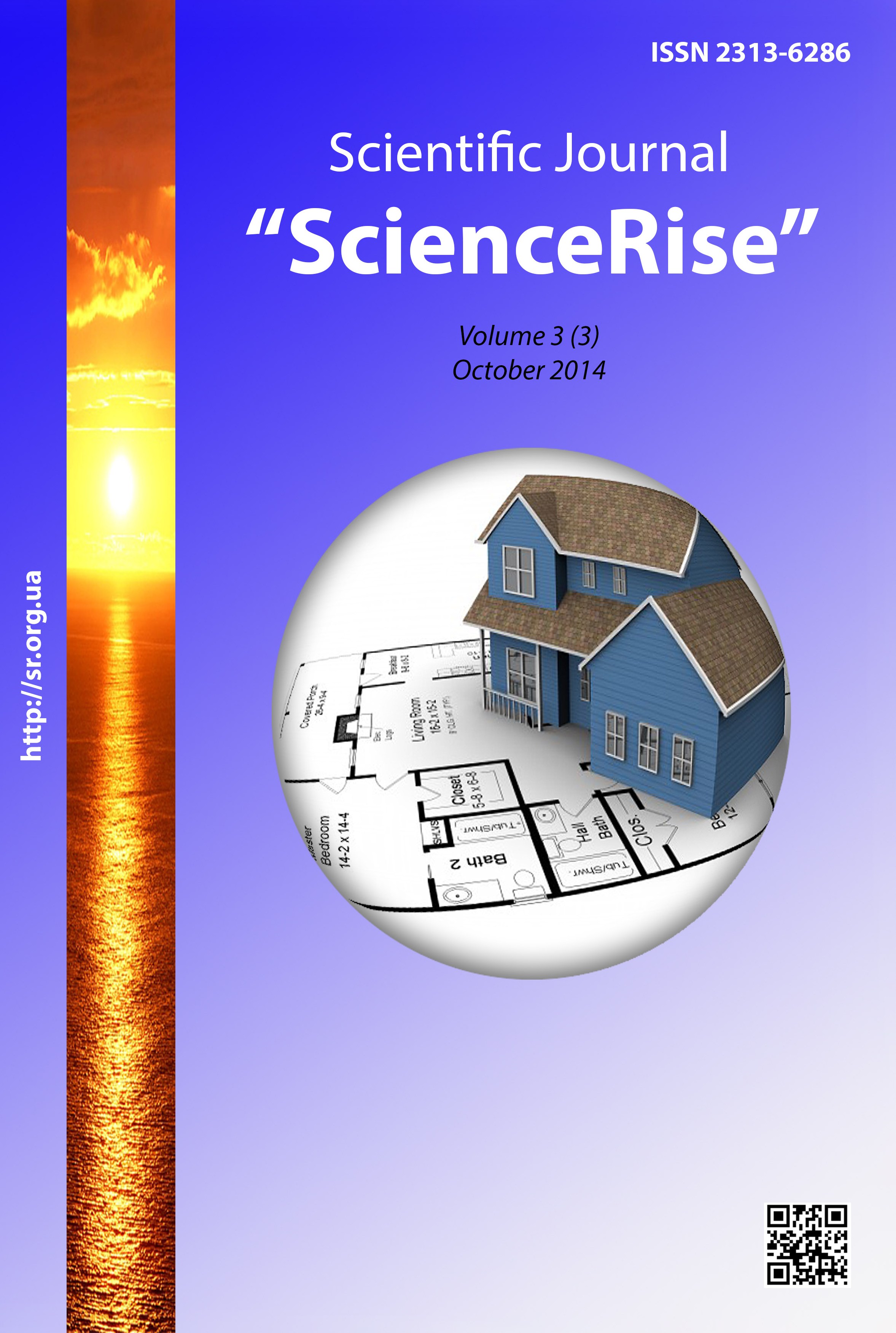Dynamics of anthocyanin in aging of ipomea purpurea flowers treated by uv-b radiation
DOI:
https://doi.org/10.15587/2313-8416.2014.27621Keywords:
anthocyanins, UV-B radiation, monocarpic plants, aging dynamicsAbstract
The dynamics of the anthocyanin content reduction in the course of aging of the Ipomoea purpureа petals, which characterizes the rate of the degradation processes in a cell, has been studied. The analysis included the impact of various UV-B radiation doses on the rate of anthocyanin age-related decomposition. The experiment proved that but one dose – 12.6 kJ/m2 contributed to the deceleration of the anthocyanin decomposition rate, within the range studied. The probable mechanisms that connect ageing and pigment degradation are being discussed.
References
1. Dubrov, A. P. (1968). Geneticheskie i fiziologicheskie jeffekty dejstvija ul'trafioletovoj radiacii na vysshie rastenija. Moscow: Nauka, 249.
2. Isachenko, M. S., Ivashhenko, N. I. (2009). Issledovanie antocianov jagodnogo syr'ja. Kachestvennoe i kolichestvennoe opredelenie. Pishhevaja promyshlennost': Nauka i tehnologii, 3 (1), 80–83.
3. Mullagulov, R. T., Timerbulatova, G. R. (2012). Kolichestvennoe soderzhanie antocianov v lekarstvennom rastitel'nom syr'e. Privolzhskij nauchnyj vestnik, 6 (2), 3–5.
4. Tanchev, S. S. (1980). Antociany v plodah i ovoshhah. Moscow: Pishhevaja promyshlennost', 304.
5. Mazza, G. (1993). Anthocyanins in fruits, vegetables and grains. Boca Raton: CRC Press Inc, 362.
6. Chalker-Scott, L. (2002). Do anthocyanins function as osmoregulators in leaf tissues? Advances in Botanical Research, 37, 103–127. http://dx.doi.org/10.1016/s0065-2296(02)37046-0
7. Jaakola, L. (2004). Activation of flavonoid biosynthesis by solar radiation in bilberry (Vaccinium myrtillus L.) leaves. Planta, 218 (5), 721–728. http://dx.doi.org/10.1007/s00425-003-1161-x
8. Steyn, W. J. (2002). Anthocyanins in vegetative tissues: a proposed unified function in photoprotection. New Phytologist, 155 (8), 349–361. http://dx.doi.org/10.1046/j.1469-8137.2002.00482.x
9. Stapleton, A. E. (1994). Flavonoids can protect maize DNA from the induction of ultraviolet radiation damage. Plant Physiology, 105 (3), 881–889. http://dx.doi.org/10.1104/pp.105.3.881
10. Harvaux, M. (2001). The protective functions of carotenoid and flavonoid pigments against excess visible radiation at chilling temperature investigated in Arabidopsis npq and tt mutants. Planta, 213 (6), 953–966. http://dx.doi.org/10.1007/s004250100572
11. Chupahina, G. N., Maslennikov, P. V. (2004). Adaptacija rastenij k neftjanomu stressu. Jekologija, 5, 330–335.
12. Gould, K. S. (2002). Do anthocyanins function as antioxidants in leaves? Imaging of H2O2 in red and green leaves after mechanical injury. Plant, Cell and Environment, 25 (10), 1261–1269. http://dx.doi.org/10.1046/j.1365-3040.2002.00905.x
13. Field, T. S., Lee, D. W., Holbrook, N. M. (2001). Why leaves turn red in autumn. The role of anthocyanins in senescing leaves of red-osier Dogwood. Plant Physiology, 127 (2), 566–574. http://dx.doi.org/10.1104/pp.010063
14. Hoch, W. A. (2003). Resorption protection. Anthocyanins facilitate nutrient recovery in autumn by shielding leaves from potentially damaging light levels. Plant Physiology, 133 (3), 1296–1305. http://dx.doi.org/10.1104/pp.103.027631
15. Grodzinskij, D. M., Gushha, N. I., Perkovskaja, G. Ju. (2002). Vlijanie hronicheskogo obluchenija na adaptivnyj potencial rastenij. Radiobiologija rastenij, 42 (2), 155–158.
16. Lange, H., Shropshire, W., Mohr, H. (1971). An analysis of phytochrome mediated anthocyanin synthesis. Plant Physiol, 47 (5), 649–655. http://dx.doi.org/10.1104/pp.47.5.649
17. Yamada, T., Ichimura, K., Kanekatsu, M. (2007). Gene expression in opening and senescing petals of morning glory (Ipomoea nil) flowers. Plant Cell Rep, 26, 823–835. http://dx.doi.org/10.1007/s00299-006-0285-4
18. Kong, J. M. (2003). Analysis and biological activities of anthocyanins. Phytochemistry, 64 (5), 923–933. http://dx.doi.org/10.1016/s0031-9422(03)00438-2
19. Harborne, J. B. (2001). Аnthocyanins and other flavonoids. Natural Product Reports, 18, 310–333.Downloads
Published
Issue
Section
License
Copyright (c) 2014 Анастасія Миколаївна Берестяна

This work is licensed under a Creative Commons Attribution 4.0 International License.
Our journal abides by the Creative Commons CC BY copyright rights and permissions for open access journals.
Authors, who are published in this journal, agree to the following conditions:
1. The authors reserve the right to authorship of the work and pass the first publication right of this work to the journal under the terms of a Creative Commons CC BY, which allows others to freely distribute the published research with the obligatory reference to the authors of the original work and the first publication of the work in this journal.
2. The authors have the right to conclude separate supplement agreements that relate to non-exclusive work distribution in the form in which it has been published by the journal (for example, to upload the work to the online storage of the journal or publish it as part of a monograph), provided that the reference to the first publication of the work in this journal is included.

